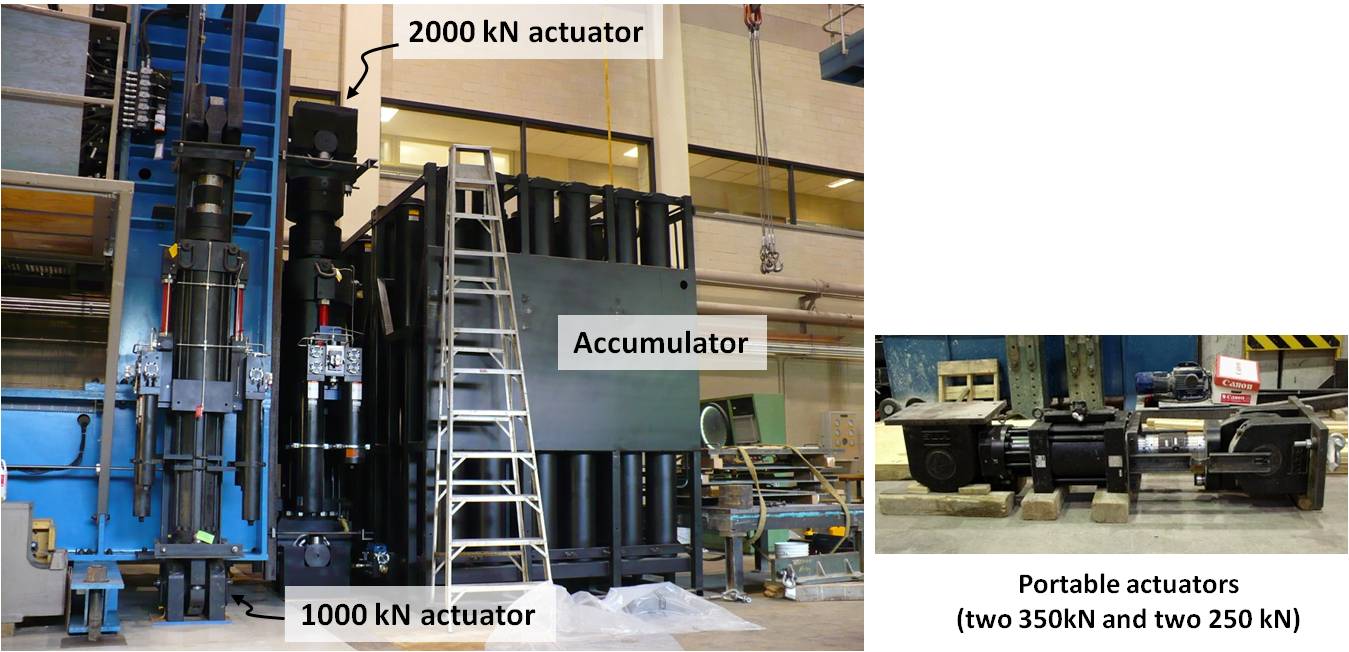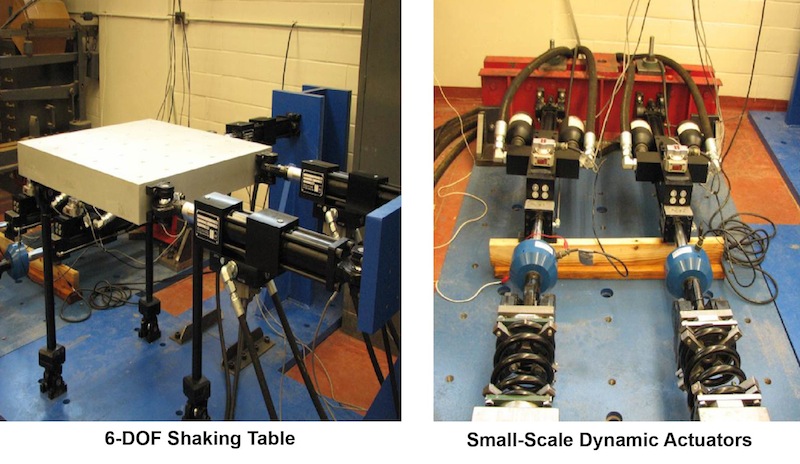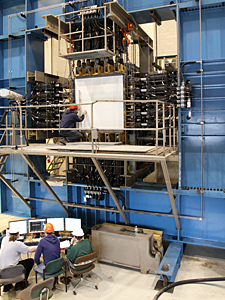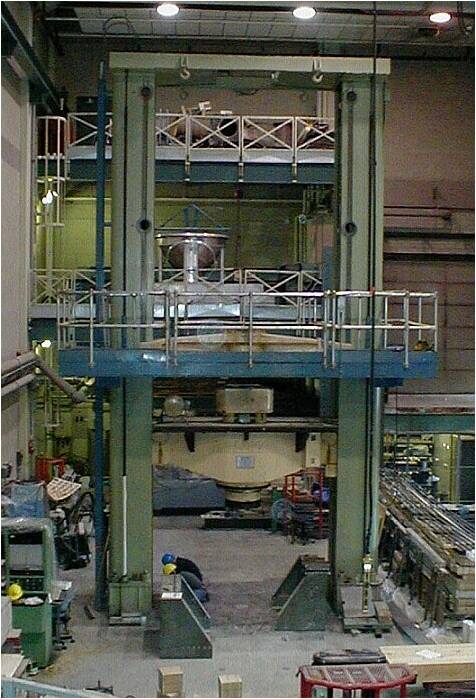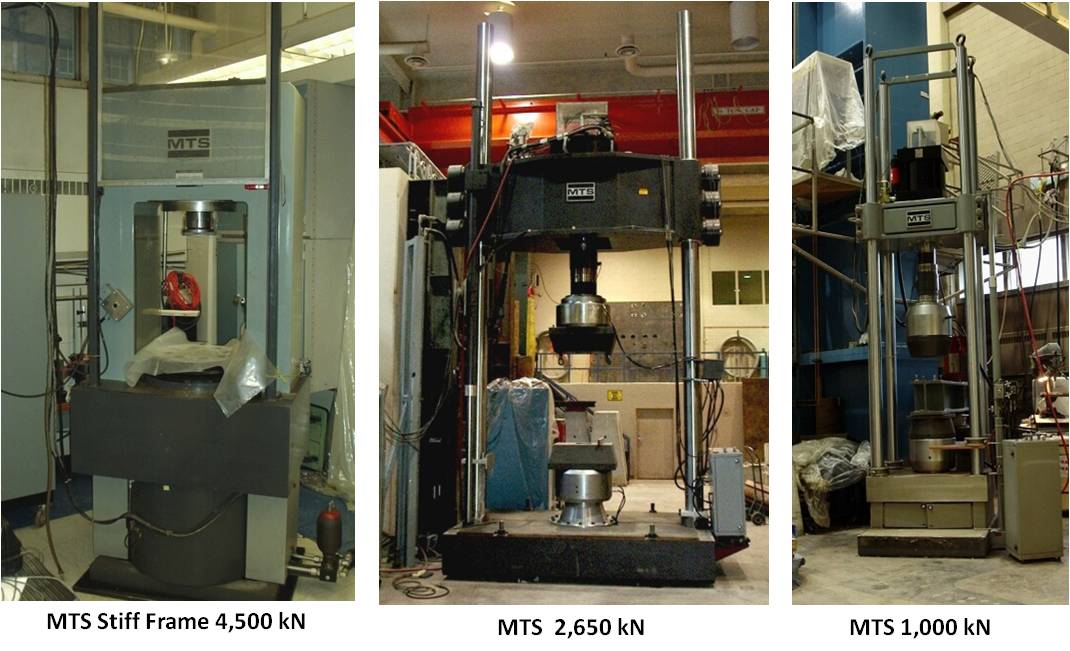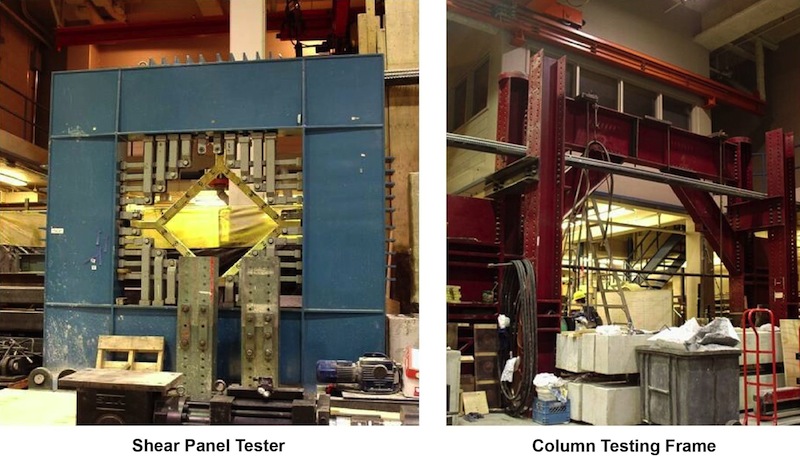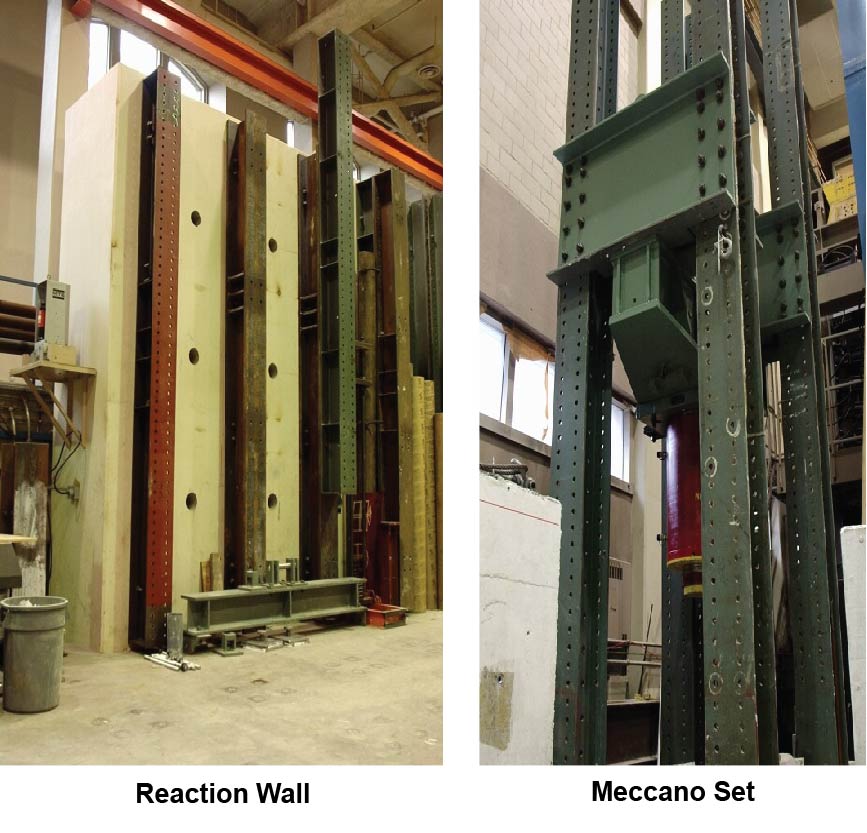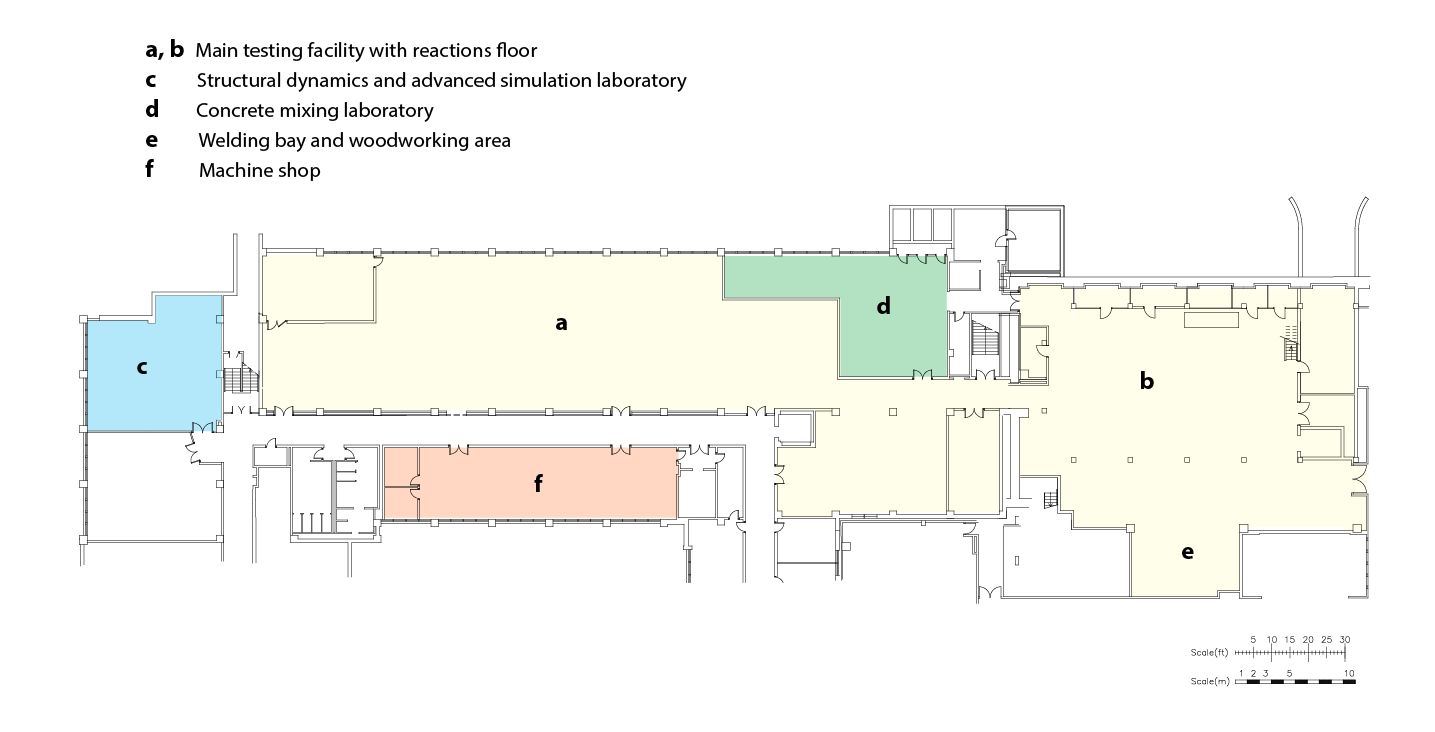
Historically, the Structural testing facility at the University of Toronto was divided into two separate laboratories, the Mark Huggins Structures Laboratory in the Galbraith building and the Sandford Fleming Laboratory. These two testing facilities were joined in 2009 as part of a large renovation and equipment upgrade sponsored by CFI and ORF and worth more than 8 Million Dollars.
The original Mark Huggins Structures Laboratory, constructed in 1960, provided the Department with one of the best such facilities in North America at that time. Experiments conducted in the laboratory have contributed significantly to the development of Canadian structural engineering codes and practice. The Mark Huggins Structures Laboratory was basically designed and equipped to test individual structural elements, (primarily individual beams and columns – i.e. bar-like specimens), under simple loading conditions. The Sandford Fleming Structures Laboratory, which has approximately 700 m2 of floor area and an 18 m x 12 m strong floor as well as a 5 m high by 5 m wide reaction wall, was constructed following a fire in 1977 and was officially opened in 1982. With the aid of an NSERC Major Installation Grant, this laboratory was then outfitted with world-class, “state-of-the-art” testing equipment for research on large scale structural specimens.
Actuators
- 2000 kN Static and Dynamic Actuator
- 1000 kN Static and Dynamic Actuators
- Small MTS Portable Actuators
- Small-Scale Dynamic Actuators
Specialty Equipment
Test Frames
- Baldwin Universal Testing Machine
- MTS Stiff Frame Testing Machine
- MTS Mobile 2700 kN Testing Machine
- MTS 1000 kN Testing Machine
- Smaller Testing Frames
- Column Testing Frame
Ancillary Equipment
- Charpy Impact Test Machine
- Strong Floor / Reaction Wall
- Full-Scale Meccano Set
- Machine Shop
- Welding Bay
- Woodworking Area
- Concrete Mixing Laboratory
- Hydraulic Power Units
2000 kN Static and Dynamic Actuator
The 2000 kN static and dynamic actuator can apply realistic forces at low and high velocities to large-scale experiments. The actuator has a maximum stroke length of 500 mm with a peak velocity of 1,000 mm/s. Possible swivel angles of +90 ° and -30 ° and tilt angles of +/- 8 ° allow for a wide range of test set-ups.
1000 kN Static and Dynamic Actuators
The two 1000 kN actuators can develop a peak velocity of 1,200 mm/s at full force under a pulse-like triangular excitation over the maximum stroke of the actuator (750 mm). They can also develop a peak velocity of 1000 mm/s under a single sinusoidal wave at +/- 300 mm and a peak velocity of 700 mm/s within a frequency range of 0.5 to 10 Hz under sustained sinusoidal loading.
Small MTS Portable Actuators
Two 350 kN capacity and two, 250 kN capacity portable actuators can be used in either of the two laboratories for a variety of specialized applications. They are normally used in conjunction with the Meccano loading frames and/or the Strong Wall and Strong Floor in the Sandford Fleming Structures Laboratory. The 1,000 kN actuator from the Column Test Frame can also be dismounted and used in this manner.
Small-Scale Dynamic Actuators
The small-scale dynamic actuators are used to develop control algorithms for real-time hybrid simulations.
Six-DOF Shaking Table
The six-DOF shaking table is equipped with three 2 kip actuators in horizontal direction and three 3 kip actuators in vertical direction. The equipment is used to understand the effect of multi-axial vibration on dynamic response of structures. In addition, the equipment also can be used as a static multi-axial loading equipment.
Shell Element Tester
The Shell Element Tester, utilized for studying the behaviour of very large reinforced concrete elements subjected to in-plane and out-of-plane forces, was initially designed in 1984 under the direction of Professor M. P. Collins and Professor P. Marti. The testing facility is unique in various aspects. It is the only facility of its kind capable of testing full scale shell elements subjected to all 8 possible force components. This piece of equipment houses 60 hydraulic jacks, 40 in-plane, which have a capacity of 1000 kN, and 20 out-of-plane, which have a capacity of 500 kN. Specimens up to 1.5 m square by 0.4 m thick can be accommodated. The SET can be used to apply bending, shear and torsional loading to regular and high-strength reinforced concrete elements, and has been used to test components of nuclear power plants and concrete offshore structures. In 2009 this piece of equipment was dramatically upgraded by equipping each of the 60 jacks with servovalves, string pots and a high-end digital controller. This upgrade now makes it possible to apply precisely controlled dynamic forces to the test panels and allows for higher strain rates than was previously possible. The Shell Element Tester achieves strain rate levels representative of what the majority of a structure that resists an extreme event is subjected to. These strain rates have never been achieved in a Shell Element Tester. There exists no similar testing device in the world that is able to apply the forces and displacements that is achievable with this new tester.
Shear Panel Tester
The Shear Panel Tester which is used to apply arbitrary in-plane stresses to thin reinforced (or prestressed) concrete panels in order to determine realistic constitutive models which can later be used by nonlinear finite element programs. This tester which includes 38 – 10,000 psi hydraulic jacks and its own control apparatus was the first of its kind in the world (first used in 1979) and has since been emulated by various research laboratories in the United States, Japan and England.
Blast Generator
The Blast Generator actuator has a 4-inch diameter bore and a 36-inch stroke. The geometric envelope with piston extended is 130 inches by 20 inches by 24 inches. The actuator can reach a peak velocity of 34 m/s. An impact spring called a programmer is mounted at the face of the impacting mass to better control the characteristics of the applied impulse. The system is capable of producing impulses of 0.5 ms to 5 ms of duration and reaches a contact pressure of 5000 psi to emulate blast pressures.
Baldwin Universal Testing Machine
This large-scale universal testing machine can apply tension / compression loads up to 5,400 kN (1.2 million lbs.), on specimens up to 6.5 meters (22 ft.) high, and 18.3 meters (60 ft.) long. This testing machine can be used to carry out a variety of tests on materials and assemblies such as wire ropes, concrete beams and steel trusses.
MTS Stiff Frame Testing Machine
This high stiffness testing machine has a capacity of 4,500 kN in compression. It can used for tests on specimens such as high strength concrete and rock samples requiring a machine with high stiffness capable of capturing post peak behaviour.
MTS 2700 kN Mobile Testing Machine
This large-scale universal testing machine can apply tension / compression loads up to 2,650 kN (0.6 million lbs.), on specimens up to 3 meters (10 ft.) high. It is capable of being moved around the Sandford Fleming Structures Laboratory using a series of air pads and can be bolted to the strong floor at any location. When coupled with the Strong Wall and various portable actuators, large, “three-dimensional”, structural sub-assemblies can be tested.
MTS 1000kN Testing Machine
This universal testing machine can apply tension / compression loads up to 1,000 kN (220,000 lbs.), on specimens up to 1.8 meters (6 ft.) high. It is capable of being moved around the Mark Huggins Structures Laboratory using the 10 ton overhead crane.
MTS 245kN Testing Machine
This universal testing machine can be used for smaller experiments and is also ideally suited for materials testing such as ASTM tensile coupons.
Riehle 60kip (45kN) Testing Machine
This is a general purpose screw driven universal testing machine with a capacity of 267 kN (60,000 pounds) which can test specimens up to 1.9 m (6.2 feet) long.
Instron 10kip (45kN) Testing Machine
This is a general purpose screw driven universal testing machine with a capacity of 45 kN (10,000 pounds) which can test specimens up to 0.6 m (2 feet) long.
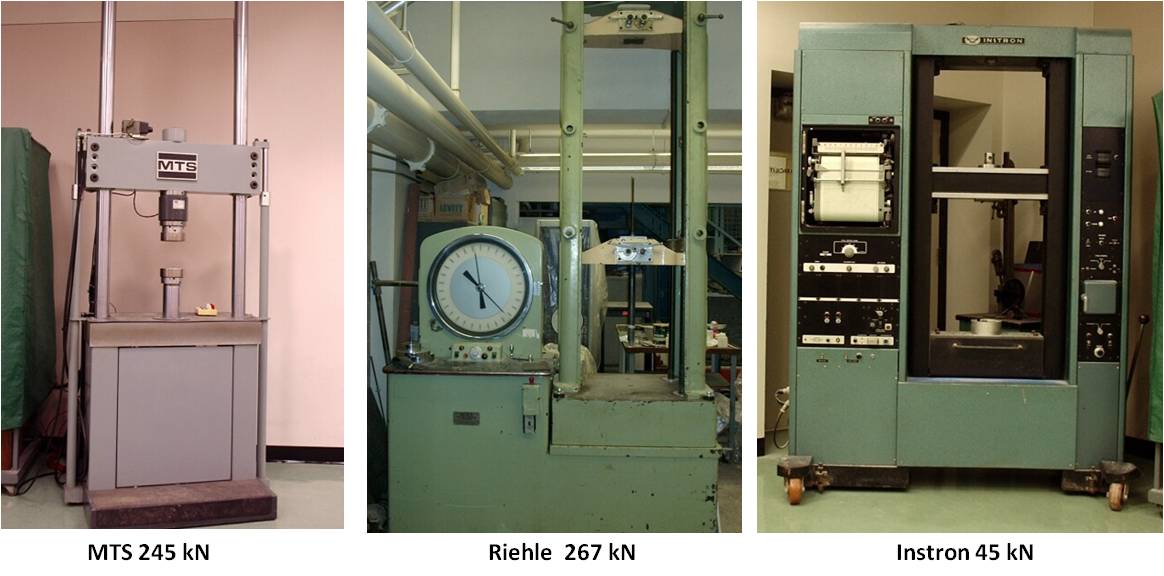
Column Testing Frame
This specially constructed frame, on extended loan from the University of Houston, houses a 4500 kN hydraulic jack for the application of axial loads and a 1000 kN servo-controlled actuator for the application of transverse loads. This frame is capable of testing specimens that are up to 4 m long while the transverse dimensions are limited by laboratory space and the strength of the materials used in the specimen. A major upgrade of this frame is currently underway which will increase the axial load capacity to 9,000 kN.
Charpy Impact Test Machine
The pendulum impact tester can be easily changed from a Charpy configuration to an Izod configuration. The tester determines the impact resistance of metals and is compliant with the specifications outlined in ASTM E23, BS EN ISO 148-3 and BS EN ISO 148-2.
Strong Floor / Reaction Wall
The Civil Engineering Structural Testing Laboratories house two strong floors, one with an associated reaction wall (Sandford Fleming Structures Laboratory). These items when combined with a diverse range of moveable steel reaction frames, beams, columns and various hydraulic jacks (up to 2 million pound capacity) and actuators, provide for systems capable of loading large two- and three-dimensional structural sub-assemblies in infinitely variable formats. Examples of test capabilities include full scale steel trusses (40 ft. long), two-storey reinforced concrete frames, precast concrete slabs, hollow structural steel (HSS) connections, and transmission pole tests.
Full-Scale Meccano Set
The Meccano system is a set of moveable steel reaction frames, beams, columns, braces etc. that can be assembled in almost limitless configurations and used in conjunction with other testing apparatus to apply loads to almost any structural component or subassembly.
Machine Shop
The Machine Shop provides services to the entire Department of Civil Engineering in addition to the Structural Testing Facility. At present two full-time machinists are employed and major equipment includes 4 milling machines, 5 lathes, 2 radial drills, 4 pedestal drills and 3 saws.
Welding Bay
The Sandford Fleming Structures Laboratory contains a modern welding bay capable of flux-cored, gas-shielded (MIG/TIG), submerged arc and stick welding processes. This welding bay is serviced by its own five ton capacity overhead crane.

Woodworking Area
A woodworking area has been integrated into the Sandford Fleming side of the Laboratory. It includes multiple saws such as a table, band, radial arm and panel saw as well as a drill and sander. To minimise dust during the operation of the equipment a dust collection system is available. This area is used for building formwork or other wooden support structures.
Concrete Mixing Laboratory
Following renovations in 1998 the concrete mixing laboratory was reopened featuring a large drain and filter system as well as aggregate hoppers which are accessible from street level. This laboratory is used by researchers of various fields: Concrete materials, Structural as well as Geotechnical. The equipment includes multiple concrete mixers, vibrators, crushers, a coring drill, surface and cylinder grinders and various types of saws. The latest addition includes a 150 l high-energy concrete mixer.
Hydraulic Power Units
The structural laboratory houses two hydraulic power units each producing 180 gpm of nominal flow at an operating pressure of 3000 psi. The units come with two surge tanks to ensure adequate oil supply for the large dynamic actuators. A hydraulic distribution system containing of a pressure, return and drain pipe spans the whole length of the laboratory. Five take-off stations are used to supply the majority of the equipment in the structural laboratory with oil.
The hydraulic power units have a designated high-voltage room with three transformers supplying 1300 kVA. A cooling tower on top of the building supplies almost one Million btu/hr required to keep the oil from heating up.
Contact
Academic Director, Structural Testing Facility
Prof. Constantin Christopoulos
Email: c.christopoulos@utoronto.ca
Phone: 416-978-6238
